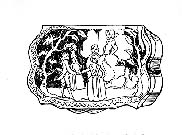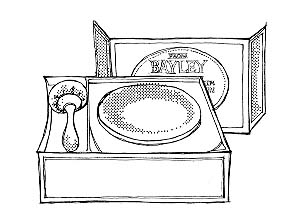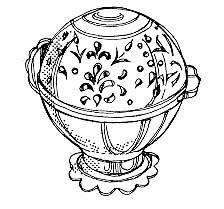The
Faces Behind the Masks: The "Toilette" in 18th Century England
Many people have the idea that the eighteenth century was a romantic
period, full of adventure and alive with cultural changes and discoveries. Few
look past the beautiful clothes and the fastidious application of cosmetics,
though the reality of personal hygene and health was completely opposite to
people's outward appearances.
While the Black Plague had ceased to decimate Europe by this time,
many diseases still ran rampant from a lack of suitable medication and sanitation
practices. Smallpox was a particularly virulent disease that left all survivors
with pock-marks on their skin --- deep pits created by pustules drying out and
scarring the epidermis. This disease is perhaps one of the biggest reasons why
almost everyone who wanted to be fashionable wore a lot of makeup in order to
hide the scars.
Step One to A Beautiful Complexion
 The picture on the left shows a "patch-box", in which pieces of silk,
taffeta, or even leather were applied to the face with an adhesive in order
to hide the pock-marks. These were considered to be quite fashionable at the
time, and were often dyed brilliant colors. (Gunn,
113.)
The picture on the left shows a "patch-box", in which pieces of silk,
taffeta, or even leather were applied to the face with an adhesive in order
to hide the pock-marks. These were considered to be quite fashionable at the
time, and were often dyed brilliant colors. (Gunn,
113.)
Other people who did not want to wear patches on their faces to
hide skin disfigurement would use a thick coat of face powder to make their
complexions look white and smooth. Unfortunately, the base element in face powder
that made people's faces look so pale was not the talc that we use today, but
finely flaked lead ! For the full, tantalizing recipe for Lead
Face Powder, click here. (WARNING: Do not recreate this at home! Lead is
easily absorbed by the body and has the side effects of severe head pain, nausea,
dizziness, bowel problems, blindness, and, if large enough amounts have been
ingested, paralyzation or even death.) (Gunn, 110.)
Many a young lady's death in the 1700's can be attributed not
only to poor sanitation in English towns and cities, but also to their avid
use of harmful cosmetics.
Applying Finishing Touches to One's
Face
 Rouge
was another favorite cosmetic. Its name is derived from the French word for
"red." Like the popular white face powder, rouge was created from
questionable ingredients, including carmine (a lead-based pigment.) People used
rouge with wet bits of wool to daub fashionable red spots on their cheeks ---
the general idea was that it made an aesthetically pleasing contrast to one's
pale, powdered face. (Gunn, 115.)
Rouge
was another favorite cosmetic. Its name is derived from the French word for
"red." Like the popular white face powder, rouge was created from
questionable ingredients, including carmine (a lead-based pigment.) People used
rouge with wet bits of wool to daub fashionable red spots on their cheeks ---
the general idea was that it made an aesthetically pleasing contrast to one's
pale, powdered face. (Gunn, 115.)
Rouge was also available as a lipstick for both men and women.
Sticks of solid rouge were created by mixing carmine with plaster of Paris (the
material used by children today to make molds of their feet in art classes.)
(Gunn, 115.)
Attending to One's Hair
Besides their complexion, women in the 1700's subjected their
hair to various tortures, the least of which was powdering their hair after
curling it with hot tongs and applying lard as the base to which the powder
would stick. Fashion demanded that women have big, complicated hairstyles with
which to complement their clothing. Many women resorted to wearing hairpieces
and wigs to add "volume" to their hair. Since many of these were difficult
to attach and sculpt on a daily basis, women often had their hair done (curled,
larded, powdered, and then adorned with small flowers and feathers) once every
few weeks and leave it unwashed so it would stay that way. (Gunn,
116.)
Not surprisingly, these ladies suffered from a lot of scalp problems.
Infestations of lice and/or fleas were common enough even among those who did
not --- or could not afford to --- enjoy such an extensive cosmetic procedure.
Those wealthier ladies who let themselves be the willing victims of fashion
often found mice nesting in their hair because the lard had attracted their
hungry attention.(Gunn, 117.)
The Kinder Side of Beauty Aids
 Fortunately,
not all beauty remedies in the 18th century had harmful side effects. While
baths were taken far and few between, people did wash themselves. (Soapholder
on left.) They usually used home-made soaps and tonics that used ingredients
that were easy to find in the garden or in a field somewhere, and everyone doused
themselves with large amounts of perfume in an effort to keep away not only
bad odor, but also what they believed caused sicknesses.
Fortunately,
not all beauty remedies in the 18th century had harmful side effects. While
baths were taken far and few between, people did wash themselves. (Soapholder
on left.) They usually used home-made soaps and tonics that used ingredients
that were easy to find in the garden or in a field somewhere, and everyone doused
themselves with large amounts of perfume in an effort to keep away not only
bad odor, but also what they believed caused sicknesses.
Return to The Apothecary
Main Page
(Gunn, 117, Fig 21.)
Main Menu of Leisure Activities
 The picture on the left shows a "patch-box", in which pieces of silk,
taffeta, or even leather were applied to the face with an adhesive in order
to hide the pock-marks. These were considered to be quite fashionable at the
time, and were often dyed brilliant colors. (Gunn,
113.)
The picture on the left shows a "patch-box", in which pieces of silk,
taffeta, or even leather were applied to the face with an adhesive in order
to hide the pock-marks. These were considered to be quite fashionable at the
time, and were often dyed brilliant colors. (Gunn,
113.) Rouge
was another favorite cosmetic. Its name is derived from the French word for
"red." Like the popular white face powder, rouge was created from
questionable ingredients, including carmine (a lead-based pigment.) People used
rouge with wet bits of wool to daub fashionable red spots on their cheeks ---
the general idea was that it made an aesthetically pleasing contrast to one's
pale, powdered face. (
Rouge
was another favorite cosmetic. Its name is derived from the French word for
"red." Like the popular white face powder, rouge was created from
questionable ingredients, including carmine (a lead-based pigment.) People used
rouge with wet bits of wool to daub fashionable red spots on their cheeks ---
the general idea was that it made an aesthetically pleasing contrast to one's
pale, powdered face. ( Fortunately,
not all beauty remedies in the 18th century had harmful side effects. While
baths were taken far and few between, people did wash themselves. (Soapholder
on left.) They usually used home-made soaps and tonics that used ingredients
that were easy to find in the garden or in a field somewhere, and everyone doused
themselves with large amounts of perfume in an effort to keep away not only
bad odor, but also what they believed caused sicknesses.
Fortunately,
not all beauty remedies in the 18th century had harmful side effects. While
baths were taken far and few between, people did wash themselves. (Soapholder
on left.) They usually used home-made soaps and tonics that used ingredients
that were easy to find in the garden or in a field somewhere, and everyone doused
themselves with large amounts of perfume in an effort to keep away not only
bad odor, but also what they believed caused sicknesses.